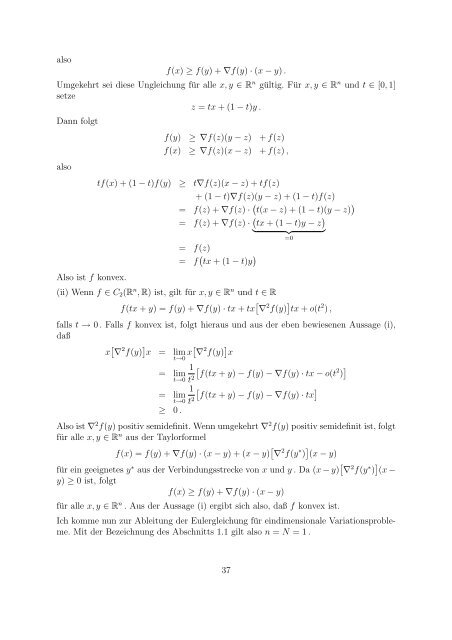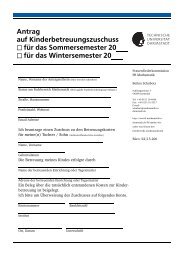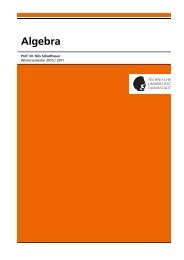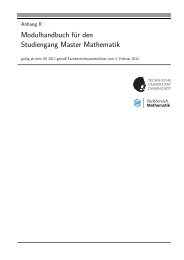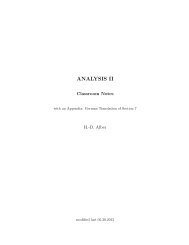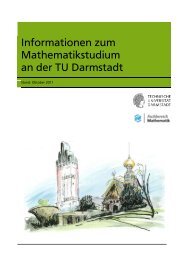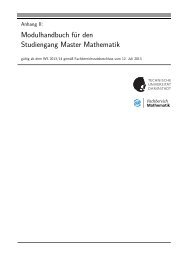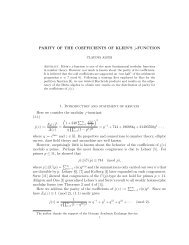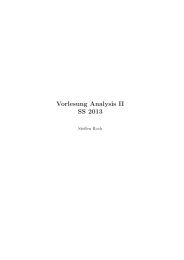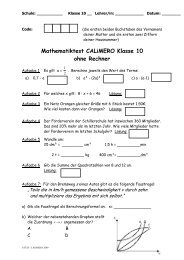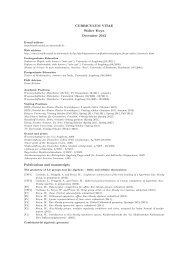Variationsrechnung und Sobolevräume - Fachbereich Mathematik ...
Variationsrechnung und Sobolevräume - Fachbereich Mathematik ...
Variationsrechnung und Sobolevräume - Fachbereich Mathematik ...
Sie wollen auch ein ePaper? Erhöhen Sie die Reichweite Ihrer Titel.
YUMPU macht aus Druck-PDFs automatisch weboptimierte ePaper, die Google liebt.
alsof(x) ≥ f(y) + ∇f(y) · (x − y).Umgekehrt sei diese Ungleichung für alle x,y ∈ R n gültig. Für x,y ∈ R n <strong>und</strong> t ∈ [0, 1]setzez = tx + (1 − t)y .Dann folgtalsoAlso ist f konvex.tf(x) + (1 − t)f(y) ≥f(y) ≥ ∇f(z)(y − z) +f(z)f(x) ≥ ∇f(z)(x − z) +f(z),t∇f(z)(x − z) + tf(z)+ (1 − t)∇f(z)(y − z) + (1 − t)f(z)= f(z) + ∇f(z) · (t(x− z) + (1 − t)(y − z) )= f(z) + ∇f(z) · (tx+ (1 − t)y − z )} {{ }=0= f(z)= f ( tx + (1 − t)y )(ii) Wenn f ∈ C 2 (R n , R) ist, gilt für x,y ∈ R n <strong>und</strong> t ∈ Rf(tx + y) = f(y) + ∇f(y) · tx + tx [ ∇ 2 f(y) ] tx + o(t 2 ),falls t → 0. Falls f konvex ist, folgt hieraus <strong>und</strong> aus der eben bewiesenen Aussage (i),daßx [ ∇ 2 f(y) ] x = limt→0x [ ∇ 2 f(y) ] x1 [= lim f(tx + y) − f(y) − ∇f(y) · tx − o(t 2 ) ]t→0 t 2 1 [ ]= lim f(tx + y) − f(y) − ∇f(y) · txt→0 t 2≥ 0.Also ist ∇ 2 f(y) positiv semidefinit. Wenn umgekehrt ∇ 2 f(y) positiv semidefinit ist, folgtfür alle x,y ∈ R n aus der Taylorformelf(x) = f(y) + ∇f(y) · (x − y) + (x − y) [ ∇ 2 f(y ∗ ) ] (x − y)für ein geeignetes y ∗ aus der Verbindungsstrecke von x <strong>und</strong> y . Da (x −y) [ ∇ 2 f(y ∗ ) ] (x −y) ≥ 0 ist, folgtf(x) ≥ f(y) + ∇f(y) · (x − y)für alle x,y ∈ R n . Aus der Aussage (i) ergibt sich also, daß f konvex ist.Ich komme nun zur Ableitung der Eulergleichung für eindimensionale Variationsprobleme.Mit der Bezeichnung des Abschnitts 1.1 gilt also n = N = 1.37


